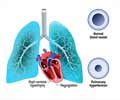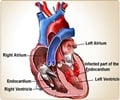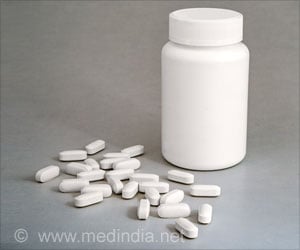Erectile dysfunction drug sildenafil, better known as Viagra, which is currently being considered as a treatment for heart failure affects males and females differently.

Specifically, in female mice modeling human heart failure, the benefits of sildenafil ranged from robust to practically nonexistent, depending on the animals' levels of the hormone estrogen, says Takimoto, an assistant professor of medicine and a researcher with the Heart and Vascular Institute at Johns Hopkins. In male mice, sildenafil generally appears to work well, but only because it targets a different biological process independent of estrogen, he says. Estrogen is present in both male and female mammals, although in different amounts.
"The research is especially significant," he adds, "because it offers a mechanism to explain how estrogen affects sildenafil's efficacy. That's the first time the actual pathway of a hormone's cause and effect on a drug has been mapped out."
Sildenafil, the generic compound used to initiate and strengthen male erections, works by encouraging blood vessels to dilate and increase blood flow to the penis. The effects are similar to some drugs, such as nitrates, already used to increase blood flow to failing hearts. Besides these effects, beneficial direct effects on heart muscles have been suggested by recent experimental studies, which is why researchers believe it could help patients with heart failure.
Heart failure is the most common reason for hospital admissions in the Medicare population, according to heart experts, and is the leading cause of death in Americans. Useful drugs such as beta-blockers and ACE inhibitors help to increase the blood-pumping efficiency of the heart, "yet they don't fully address the ongoing pathology," says Takimoto.
Whether due to a heart attack, hypertension, arteriosclerosis or other reasons, even moderate injury to heart muscle cells can initiate a downhill remodeling of broad areas of heart tissue, including enlargement of the heart and stiffening of heart chambers as fibrous proteins replace more flexible ones in muscle cells. The weakened and altered heart muscle compromises circulation, a hallmark of heart failure.
"Because cardiac remodeling is an underlying mechanism," Takimoto says, "we've put more than a decade of research into understanding it enough to stop or reverse it."
Key to the Johns Hopkins team's research, Takimoto says, is the molecule cyclic guanosine monophosphate (cGMP), which trips a helpful biochemical cascade that can counter effects of hypertension and other stressors. Heart cells typically maintain a strategic pool of cGMP, but heart-damaging events deplete this pool via the disabling action of an enzyme called PDE5. That's where sildenafil comes in.
As a potent inhibitor of PDE5, sildenafil increases cell levels of cGMP, which helps erectile dysfunction. More recently, research has explored the drug's ability to raise cGMP levels for cardiac disease.
In 2005, Takimoto's group studied sildenafil in mice engineered to have so-called transverse aortic constriction (TAC). A surgically-fitted band around the aorta in mice with TAC raised their internal heart pressure.
The result was cardiac remodeling, and then signs of classic human heart failure. "By increasing cGMP with sildenafil, we both blocked and reversed remodeling in the animals, ameliorating heart failure," Takimoto says.
Subsequent work by other research groups with various animal models showed similar effects, laying groundwork for human heart disease studies.
The new gender-based findings are especially interesting, Takimoto says, because of contradictory results of early clinical trials with sildenafil for heart failure. Notably, he says, a small, single-center clinical study showed sildenafil's long-term positive effects against cardiac remodeling and classic human heart failure. But last year, results of the RELAX study - a National Institutes of Health-sponsored, 26-center U.S. and Canadian study testing sildenafil against placebo for diastolic heart failure, a difficult-to-treat type of heart failure - found essentially no benefit.
To better understand the protective effects of cGMP activity, Takimoto's team focused on the tie-in with estrogen, also known to be naturally cardioprotective. Women, for example, develop heart disease much later on average than men, usually after menopause and estrogen depletion; estrogen feeds into the cGMP pathway. But this new study by Takimoto's group used sildenafil to shed more light on the process.
The team used both the TAC model and an established, powerful, gene-based model of heart failure that together better reflected human heart failure, according to Takimoto. Half of the female mice his team tested had their ovaries removed, which meant these mice had minimal levels of estrogen. Both groups of female mice received sildenafil. As expected, all the mice developed cardiac remodeling, but those low in estrogen fared far worse. Treating the estrogen-low mice with supplements of the hormone, however, raised cGMP and reversed heart damage. "This tells us that estrogen critically impacts the response to sildenafil in heart failure treatment," Takimoto says.
Male mice, which have naturally low amounts of estrogen, fared differently. Like the females, they had cardiac remodeling. But sildenafil alone was able to stop it.
Takimoto explains the gender effect as a difference in male-female physiology: "In female mice, their normally high estrogen levels insure presence of an ongoing pool of cGMP with its protective effects. In males, however, there's no such pool of cGMP. It's synthesized only in response to stress on the heart."
"Our findings may have important clinical implications," he and study first author Hideyuki Sasaki, M.D., Ph.D., say. They cite the RELAX trial, where half of the participants were 69 or older. That's long after menopause started for women in the trials. "Knowing that sildenafil's benefits to female mice come only with higher estrogen levels offers a possible reason for RELAX's negative results," says Takimoto.
That and the ability of added estrogen to turn around a poor sildenafil response in the mice, he adds, "suggest we need to look more into female-specific strategies with these therapies."
Other Johns Hopkins researchers involved in the research include David A. Kass, M.D.; Kinya Seo, Ph.D.; Manling Zhang, M.D.; Guangshuo Zhu, M.D.; Dong I. Lee, Ph.D.; Djahida Bedja, M.S.; and Steven Hsu, M.D. Researchers from Tufts University, Osaka University, the National Cerebral and Cardiovascular Center in Osaka and the Mendelsohn Consulting Group in Boston also contributed.
This work was supported by the National Institutes of Health's National Heart, Blood and Lung Institute (HL-093432 and HL-089297), the American Heart Association, the Japan Heart Foundation/Bayer Yakuhin Research Grant Abroad, the Muscular Dystrophy Association, Fondation Leducq, and the Abraham and Virginia Weiss Endowment.
Johns Hopkins Medicine (JHM), headquartered in Baltimore, Maryland, is a $6.7 billion integrated global health enterprise and one of the leading health care systems in the United States. JHM unites physicians and scientists of the Johns Hopkins University School of Medicine with the organizations, health professionals and facilities of The Johns Hopkins Hospital and Health System. JHM's vision, "Together, we will deliver the promise of medicine," is supported by its mission to improve the health of the community and the world by setting the standard of excellence in medical education, research and clinical care. Diverse and inclusive, JHM educates medical students, scientists, health care professionals and the public; conducts biomedical research; and provides patient-centered medicine to prevent, diagnose and treat human illness. JHM operates six academic and community hospitals, four suburban health care and surgery centers, and more than 30 primary health care outpatient sites. The Johns Hopkins Hospital, opened in 1889, was ranked number one in the nation for 21 years in a row by U.S. News & World Report.
Source-Newswise















